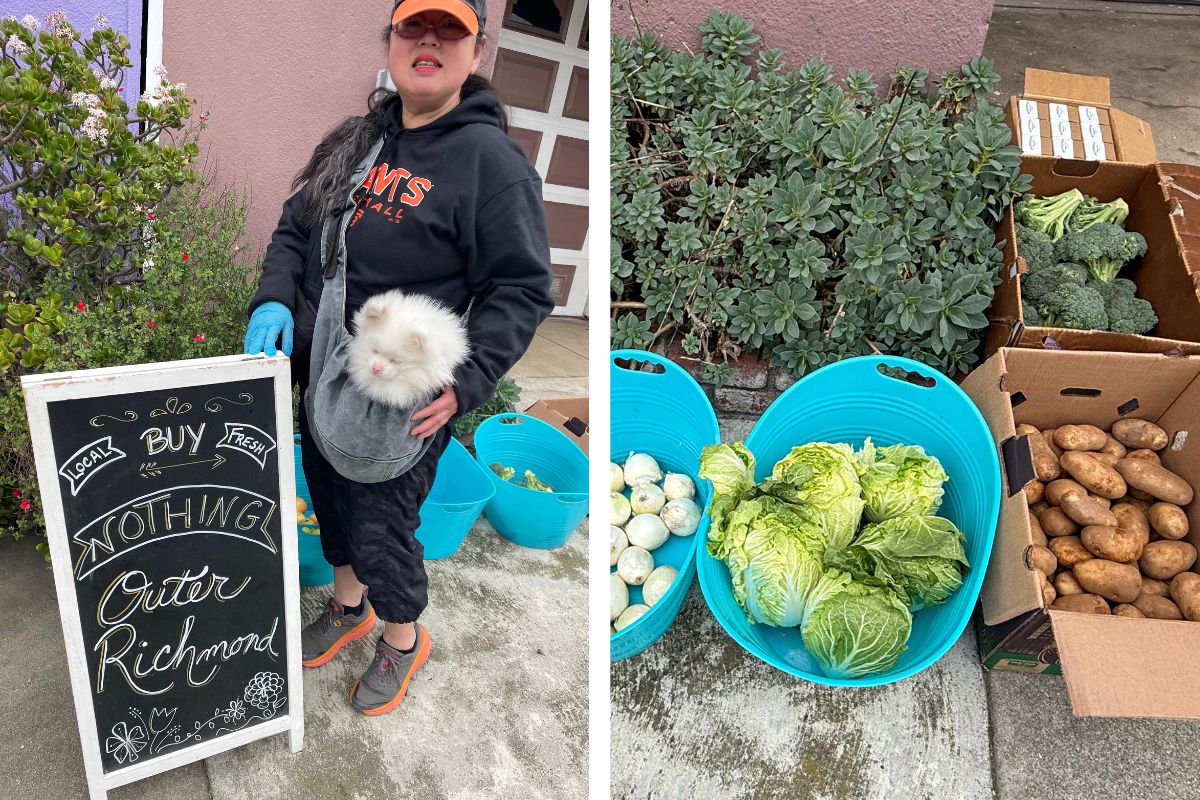Motivated to help her neighbors during the pandemic, Priscilla Lee used the Buy Nothing platform to organize food pickups from her garage. Four years later, the pantry perseveres, along with the community it’s inspired.

Motivated to help her neighbors during the pandemic, Priscilla Lee used the Buy Nothing platform to organize food pickups from her garage. Four years later, the pantry perseveres, along with the community it’s inspired.
March 24, 2025

Priscilla “Cilla” Lee opened a food pantry in a San Francisco neighborhood during the pandemic, and it’s still going strong. (Photo credit: Tilde Herrera)
A version of this article originally appeared in The Deep Dish, our members-only newsletter. Become a member today and get the next issue directly in your inbox.
Expand your understanding of food systems as a Civil Eats member. Enjoy unlimited access to our groundbreaking reporting, engage with experts, and connect with a community of changemakers.
Already a member?
Login
Priscilla “Cilla” Lee gave away nearly 50,000 pounds of food last year to her neighbors in San Francisco’s Outer Richmond district.
She has hosted a weekly food pantry from her garage since 2021, stocking it with donations from local food banks, grocery stores, restaurants, bakeries, and anywhere else she can get free food for her community. Every Friday and two Saturdays a month, she hands out food boxes filled with fresh fruit, vegetables, meat, dairy products, and dried goods like beans or rice. She still serves between 40 and 50 families per week, and 25 families come on Wednesdays, when she gives away baked goods donated by a local bakery.
In a recent week, she shared four boxes of bread and pastries and 20 pizzas. She also gave away 120 boxes of mangoes donated by a food bank and trays of papaya salad and spring rolls provided by a caterer.

Since 2022, Lee has doubled her volunteer team to 40 or 45 people and added more structure. Last year, they gave away nearly 50,000 pounds of food to neighbors in San Francisco’s Outer Richmond district. (Photo credit: Tilde Herrera)
Lee, 54, began hosting the food pantry out of her garage in 2021, alarmed by the level of food insecurity in her neighborhood during the pandemic. She was inspired to help others by her late mother, who had always tried to give her family, friends, and acquaintances a hand, even during her cancer treatment. Also, Lee was on leave from her airline job, giving her a bit of extra time—and was volunteering with local food banks, which had surplus food. Starting a neighborhood food project just made sense.
Civil Eats first covered Lee’s food pantry in 2022, when she was inviting free pickups through two local branches of Buy Nothing, an online network of neighborhood groups that share everything from extra food to old clothes and used appliances as part of a gift economy model.
Lee is an administrator for the official Outer Richmond Buy Nothing group, which has 1,100 members, and the Richmond-Sunset Buy Nothing group, which has 2,200 members. Now she limits slots for food pickup to ensure enough food for the core set of regulars who have relied on the pantry for all these years.
These regulars include Yulia Koudriashova, a single mom and teacher who saves nearly $300 a month by getting most of her family’s food through Lee’s pantry. She lives with her two daughters and her parents, who moved in three years ago after fleeing Ukraine when Russia invaded. “My parents’ income is zero in the United States,” Koudriashova says. “For them, it’s very important support because mentally, it’s very important that they know they can get food.”
Koudriashova’s mother spends her days cooking everything they receive from the pantry, and her father volunteers at the pantry a few days a week, unloading boxes or sorting food, despite not speaking any English. He worked as an engineer in Ukraine but is unable to work in the U.S., so he is happy to have a “job” and help others as he often did for his neighbors back home, Koudriashova says. Everyone calls him “Papa.”
“When he began to do it, he became alive, because it’s a very important role, mission,” Koudriashova says. “He tells us, ‘I’m working today,’ so we know he needs to go and help. He loves it a lot.”
Since 2022, Lee has doubled her volunteer team to 40 or 45 people and added more structure. She has two volunteer administrators who create pantry schedules and sign-up sheets, as well as a third administrator who sends weekly reminders for volunteers to sign up for picking up donations or setting up the pantry. At each pantry, one or two hosts oversee the food pickups and support the pantry assistants, who receive the food donations and get food ready to be given out. About 75 percent of her volunteers are pantry recipients themselves.
Lee asks for a three-month commitment when recruiting volunteers, who donate their time and gas. “I’m donating my sanity and my family’s time—my partner also helps,” Lee says. “No one’s getting paid from this pantry.”
Annelissa Reynoso, a part-time restaurant manager and student, has been volunteering at the pantry for the past year. She met Lee through the Buy Nothing Facebook group when she was giving away a fruit platter. Lee claimed it and asked Reynoso if she was interested in volunteering.
“My parents’ income is zero in the United States. For them, it’s very important support because mentally, they know they can get food.”
Reynoso, 25, saw it as a sign to take action at a time when life felt overwhelming. The Israel-Hamas war was raging, and Reynoso felt helpless, hopeless, and disconnected. She began volunteering with Lee, working her way up from pantry assistant to host. She also drives to pick up donations and gives rides to neighbors who want to visit the pantry.
“I feel like I’m finally part of a community,” Reynoso says. “I’ve wanted to feel this way for a long time.”
Reynoso had already considered herself to be a human rights activist but says Lee has influenced her to consider a career helping unhoused, immigrant, or low-income communities.
“That’s awesome,” Lee says, of her friend’s new direction. “I love it.”
The Buy Nothing Project continues to resonate with people a dozen years after its launch, says founder Liesl Clark, a documentary filmmaker who was fascinated by the cashless gift economies she saw in communities throughout the Himalayas. There are now more than 8,000 Buy Nothing groups on Facebook, representing 12.5 million people, and another 1.4 million people using the Buy Nothing app.
The app has added a global feed for users who are interested in a broader circular economy, Clark says. Rather than buying a product on Amazon, users can now search for it in Buy Nothing’s global feed or post an item they haven’t had success gifting locally. If they find the product, or a taker, they can use Buy Nothing shipping to receive or send the item through UPS.
“We still aim to provide every community that wants one, a gift economy, so community members can get to know each other and connect through our stuff and services offered,” Clark said in an email. “We know this builds connected neighborhoods, which is a building block toward resiliency, mutual aid, and healthy, human-centered cities and towns.”
Food donations have been unpredictable for the last 18 months, Lee says. With fewer donations, Lee must give less food to each family. She consistently receives high-quality donations from the Second Harvest food bank every week, but she says other food banks are giving her less food now compared to during the pandemic. That contribution could further decline in the wake of unsteady federal funding for the Local Food Purchase Assistance Cooperative Agreement Program, designed to move local farm harvests into food banks.
“We still aim to provide every community that wants one, a gift economy, so community members can get to know each other and connect through our stuff and services offered.”
Lee estimates that she spends 32 to 40 hours a week working on the pantry. It’s more manageable since she retired in October from her airline job; when she was working, she often spent time on pantry-related tasks before and after work and during her lunch breaks.
In addition to the day-to-day logistics, Lee also keeps tabs on everyone’s food preferences. For example, she makes sure Koudriashova’s family gets plenty of their beloved potatoes and sets aside extra beans for a Hispanic family who visits the pantry. This ensures people get food they like to eat, and that food is not wasted.
It’s a lot of work to run the pantry, and the food-supply situation can be unnerving, but hearing about how the project has impacted people’s lives drives Lee to keep going.
For example, Koudriashova uses the money she saves on groceries to pay for gymnastics lessons for one of her daughters. She says she wouldn’t be able to afford those lessons without the pantry. “When I go to the shop, I buy only some food for the kids to make sandwiches for the school lunch,” Koudriashova says. “Otherwise, we use all the products that we have from this pantry. I don’t know how we would survive without Cilla.”
Lee says she had no idea she would still be running this pantry, years after it began.
“I will try my best to keep the pantry going until either I am no longer receiving food donations or community [volunteers], and as long as I am healthy, my family is healthy, and I am not neglecting my own family.”
She says none of her volunteers want to take over the pantry. For now, seeing how it has alleviated financial stress for her neighbors motivates her to continue.
Although Lee didn’t start the pantry to inspire others or seek recognition, she says she has often been told by her community, volunteers, and peers that she motivates them to help others. Which, in fact, they do.
“It is a very powerful feeling, and I feel overwhelmed by the positive feedback,” Lee says. “It reminds me of how my mother would be so proud of the person she raised.”

July 30, 2025
From Oklahoma to D.C., a food activist works to ensure that communities can protect their food systems and their future.
Like the story?
Join the conversation.